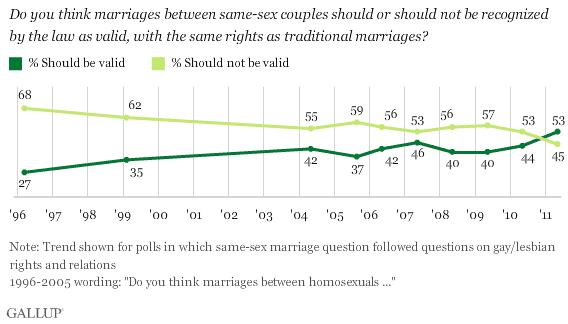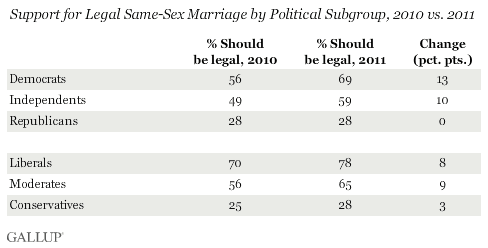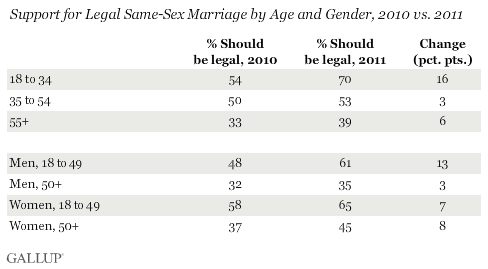PRINCETON, NJ -- For the first time in Gallup's tracking of the issue, a majority of Americans (53%) believe same-sex marriage should be recognized by the law as valid, with the same rights as traditional marriages. The increase since last year came exclusively among political independents and Democrats. Republicans' views did not change.

These results are based on Gallup's May 5-8 Values and Beliefs poll, which has tracked attitudes toward legalizing same-sex marriage each year since 2004, adding to Gallup's initial polling on the topic in 1996 and 1999.
This year's nine-percentage-point increase in support for same-sex marriage is the largest year-to-year shift yet measured over this time period. Two-thirds of Americans were opposed to legalized same-sex marriage in 1996, with 27% in favor. By 2004, support had risen to 42% and, despite some fluctuations from year to year, stayed at roughly that level through last year.
Democrats' and Independents' Greater Acceptance Shifts the Balance
Democrats' and independents' support for legalized same-sex marriage increased this year by 13 and 10 points, respectively. Republicans' views on the issue did not change from last year. Clear majorities of both Democrats and independents now support gay marriage, 69% and 59% respectively, contrasted with 28% support among Republicans.
Majorities of moderates and liberals support gay marriage, as they did last year, contrasted with 28% of conservatives.

Support for Legal Same-Sex Marriage Decreases Sharply With Age
Support for legal gay marriage decreases markedly with age, ranging from 70% support among those aged 18 to 34, to 39% support among those 55 and older. More broadly, support is highest among younger women and lowest among older men.
Compared with last year, support for legalizing same-sex marriage increased most among younger, 18- to 34-year-old Americans, and among men under 50.

Support for legal same-sex marriage is higher among those who attend church less frequently, among Catholics than among Protestants, and among those who are unmarried.
Implications
This year marks a significant uptick in support for legalizing same-sex marriage, exceeding the symbolic 50% mark for the first time in Gallup's history. Support rose from 27% in 1996 to the low 40% range in 2004 and remained fairly constant through last year.
The issue does, however, remain highly divisive. While big majorities of Democrats and young people support the idea of legalizing same-sex marriage, fewer than 4 in 10 Republicans and older Americans agree. Republicans in particular seem fixed in their opinions; there was no change at all in their support level this year, while independents' and Democrats' support jumped by double-digit margins.
Within the past year, Congress passed and President Obama signed a law allowing gay and lesbian members of the military to openly reveal their sexual orientation, rather than keeping it hidden as part of the "Don't Ask, Don't Tell" policy. A majority of Americans have supported such a change in policy since 2005, rising to two-thirds support in 2009 and again last year. It is unclear whether the highly publicized official change in government policy on Don't Ask, Don't Tell may have been a factor in the rise in Americans' support for legalizing same-sex marriage.
Most legislation dealing with legalizing same-sex marriage occurs at the state level. At this point, five states -- Connecticut, Iowa, Massachusetts, New Hampshire, and Vermont, plus the District of Columbia -- allow legal same-sex marriages. Most of the remaining states specifically outlaw it. At the moment, those advocating changes in constitutions and laws to allow same-sex marriage in additional states can take heart in the apparent shift in national sentiment in their direction.
Survey Methods
Results for this Gallup poll are based on telephone interviews conducted May 5-8, 2011, with a random sample of 1,018 adults, aged 18 and older, living in all 50 U.S. states and the District of Columbia.
For results based on the total sample of national adults, one can say with 95% confidence that the maximum margin of sampling error is ±4 percentage points.
Interviews are conducted with respondents on landline telephones and cellular phones, with interviews conducted in Spanish for respondents who are primarily Spanish-speaking. Each sample includes a minimum quota of 400 cell phone respondents and 600 landline respondents per 1,000 national adults, with additional minimum quotas among landline respondents for gender within region. Landline telephone numbers are chosen at random among listed telephone numbers. Cell phones numbers are selected using random digit dial methods. Landline respondents are chosen at random within each household on the basis of which member had the most recent birthday.
Samples are weighted by gender, age, race, Hispanic ethnicity, education, region, adults in the household, and phone status (cell phone-only/landline only/both, cell phone mostly, and having an unlisted landline number). Demographic weighting targets are based on the March 2010 Current Population Survey figures for the aged 18 and older non-institutionalized population living in U.S. telephone households. All reported margins of sampling error include the computed design effects for weighting and sample design.
In addition to sampling error, question wording and practical difficulties in conducting surveys can introduce error or bias into the findings of public opinion polls.
View methodology, full question results, and trend data.
For more details on Gallup's polling methodology, visit www.gallup.com.
